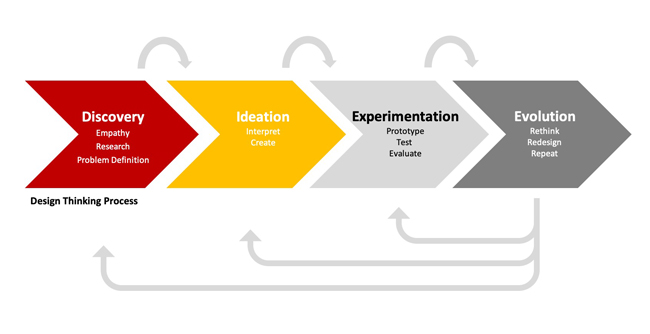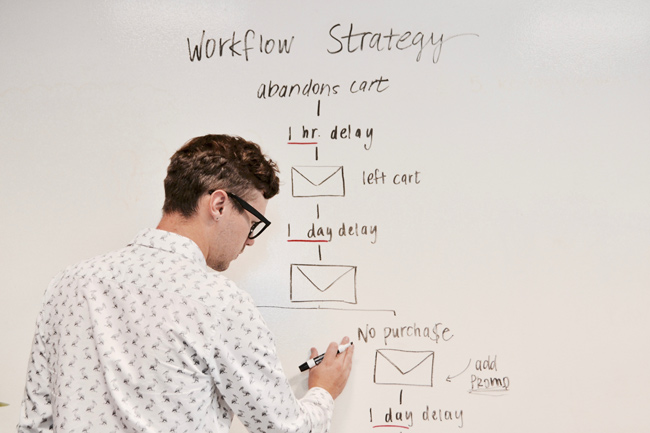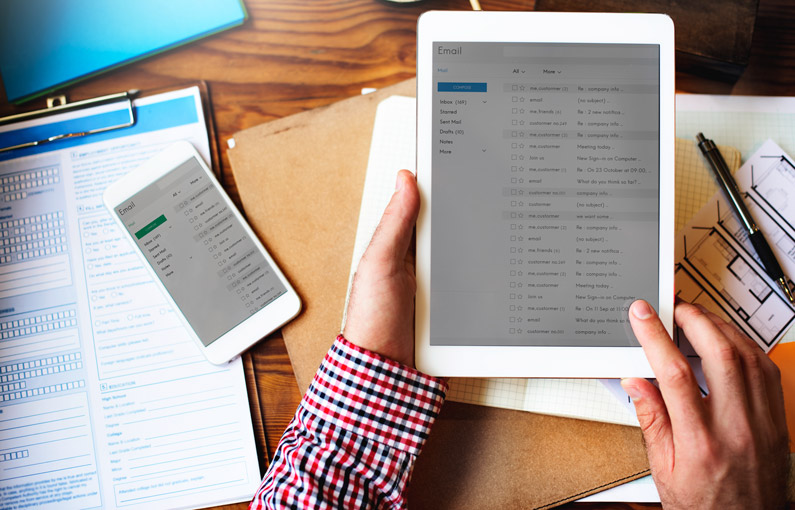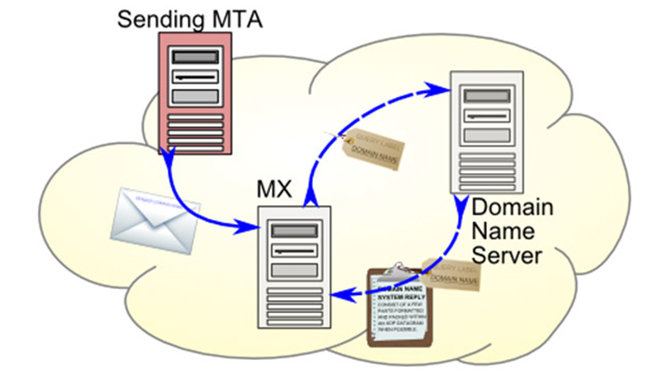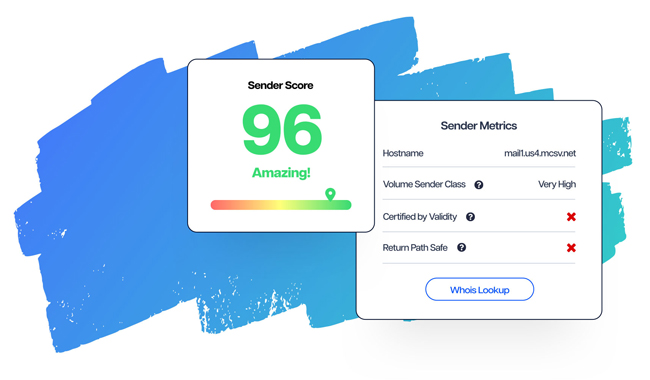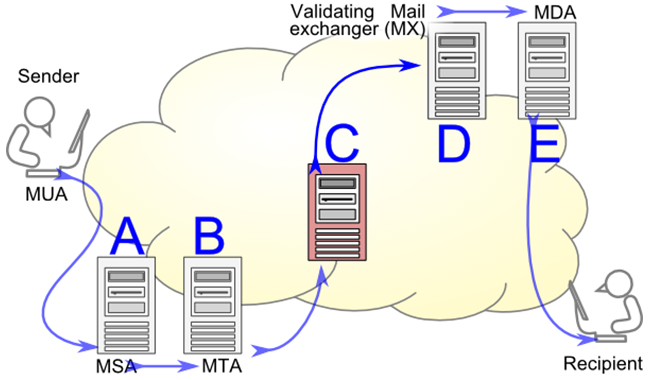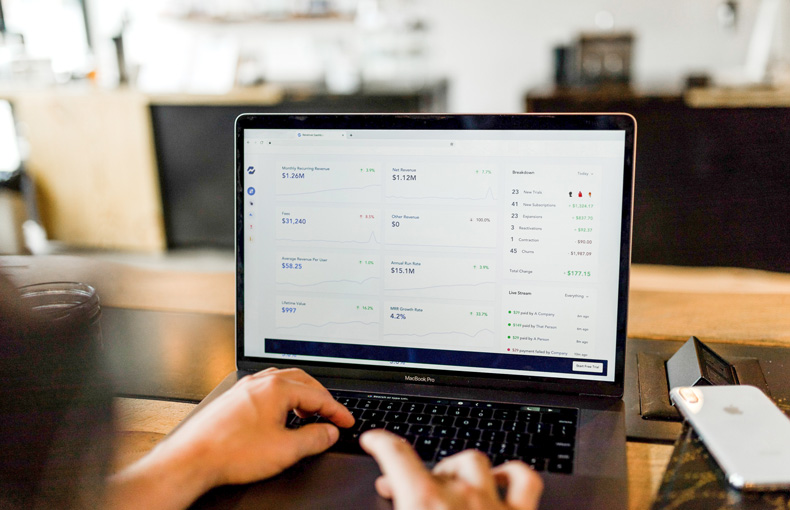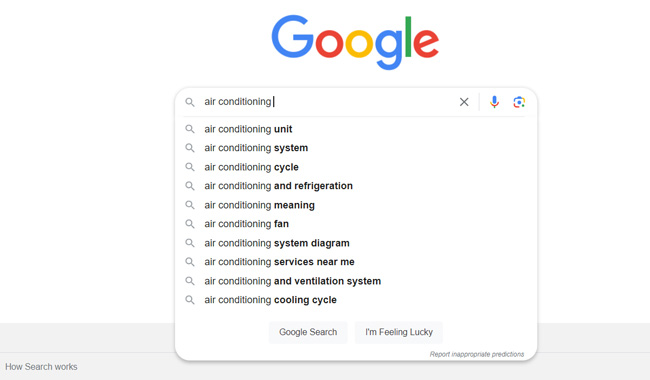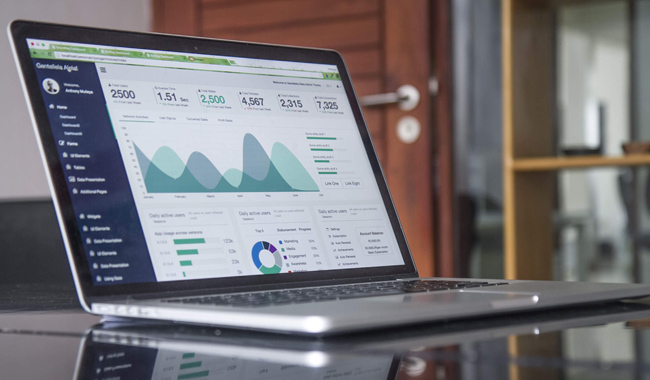Imagine for a moment you’ve just designed the perfect survey, one that’s poised to yield the most insightful data your organization has ever collected.
It’s thorough, intuitive, and clearly articulated.
For example, you can say, “Your There’s just one problem. Is it compelling enough to make your audience click through and actually participate in your survey?
If you’re not sure, this article will set you on the right path by highlighting:
- The anatomy of effective survey invitation emails: what they include and why
- A detailed examination of three survey template types: customer satisfaction, product/service feedback, and market research
- The impact of each survey template on your digital marketing efforts
- How well-structured survey emails can boost response rates
Customer Satisfaction Survey Email Templates
“We see our customers as invited guests to a party, and we are the hosts. It’s our job every day to make every important aspect of the customer experience a little bit better.”
— Jeff Bezos
Customer satisfaction is a crucial metric for any business. High customer satisfaction not only boosts profits but also reduces future selling costs because businesses retain satisfied customers.
Email surveys are an effective tool to gauge customer satisfaction levels. Customer satisfaction survey email templates will enable you to:
- Gain insight into customer preferences: These templates can be used to gather crucial information about what your customers like and don’t like about your products or services.
For example, if a majority of your customers rate a particular feature of your product poorly, you’ll know it’s an area to improve.
On the other hand, if another feature is consistently well-received, you’ll know it’s a selling point to emphasize in future marketing efforts. - Evaluate customer service quality: You can use these templates to ask customers about their interactions with your customer service team.
If customers are generally happy with the support they receive, that’s great—it’s something you can proudly showcase in your marketing. If not, you’ve identified an area where you can work to improve the overall customer experience. - Identify brand advocates: Customers who rate their experiences highly might be willing to become brand advocates or provide testimonials, which can be used in marketing materials.
You can even use a survey to ask directly if customers are willing to refer others to your business or provide a review. - Make data-driven marketing decisions: The feedback from these surveys will help you make more informed, data-driven decisions about your marketing strategy.
Rather than guessing what messaging will resonate with your audience, you can use their feedback to guide your approach. - Improve personalization techniques: The responses can also guide personalized marketing. If a customer expresses interest in a specific product category in the survey, you can segment your email list to send targeted marketing emails about that product.
From Invitation to Action: Harnessing the Power of Compelling Templates
To craft an effective customer satisfaction survey template, OnDigitalMarketing recommends employing proven survey techniques.
Start with an engaging subject line like “We’d Love Your Feedback” or “Help Us Improve Your Experience.”
Follow this up with a personalized greeting that includes the customer’s name, if possible, a well-established technique to increase response rates.
Other key elements to include are:
- Clear purpose: Explain why you’re reaching out and why their feedback matters. Customers are more likely to respond when they understand their opinions can make a real difference.
- Concise survey: Keep the survey concise and easy to answer by focusing on thoughtful question design. Scale ratings (1–5 or 1–10), multiple choice, and yes/no questions work well. An option for comments can also be helpful for more detailed feedback.
- Visible call-to-action: Make it easy for customers to start the survey with a clear, prominent call-to-action button. For example, “Take the Survey” or “Share Your Thoughts.”
- Incentive (optional): If it fits your business model, consider offering a token of appreciation for their time, like a discount on their next purchase or entry into a giveaway.
- Thank you & goodbye: Conclude by expressing gratitude and let them know how you’ll use their feedback. This reinforces the value of their participation and leaves them with a positive impression.
Incentive Example: As a token of our gratitude, complete the survey for a 10% discount on your next purchase. Your feedback matters!
Check out the sleek email template of a customer satisfaction survey below. It’s got a neat layout, eye-catching visuals, and super clear buttons to click on.
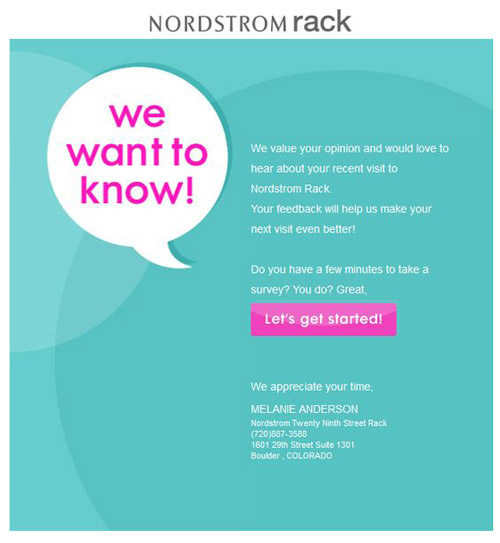
Here is a list of web pages that have customer satisfaction survey email templates:
- 8 Best Customer Satisfaction Survey Email Examples (Xola)
- 3 Effective Customer Satisfaction Survey Email Templates (The Jotform Blog)
- 15 Survey Email Templates To Get More Responses (EmbedSocial)
- Measure Satisfaction: 9 Survey Email Templates & Examples (Sender)
- 7 Amazing Customer Satisfaction Email Templates You Can Grab Today (Survicate)
Customize Your Own Templates
Need inspiration to help get you started? Download a free template and customize for your online store. Add your own voice, product images, discounts, offers and signature style.
Example 1
Example 2
Product/Service Feedback Email Templates
“Your most unhappy customers are your greatest source of learning.”
— Bill Gates
Collecting feedback on products or services is essential for businesses to understand customer needs and improve their offerings.
Product/service feedback email templates provide marketers with a structured approach to:
- Improve customer engagement: Regularly reaching out for feedback lets your customers know that their opinions are valued. It builds a strong relationship with them, encouraging brand loyalty.
- Inform strategy and product development: The feedback you receive will give you a clear picture of what’s working and what’s not in terms of your product or service. You can then work on improving where necessary.
- Personalize customer experience: Feedback often highlights individual customer preferences. Using this data, you can tailor your approach, messaging, and even your products to better meet their needs.
Feedback from product/service templates can also help you:
- Create content: Testimonials, reviews, and customer stories gathered through feedback emails can be repurposed into content for marketing. These materials are very persuasive because they come directly from customers.
- Nurture leads: When someone provides feedback, it opens up a line of communication. This is a perfect opportunity to nurture that customer toward further purchases or to address any concerns that might have prevented them from purchasing again.
- Identify brand advocates: Customers who give positive feedback and regularly engage with your emails are potential brand advocates. They can be a gold mine for word-of-mouth marketing, which remains one of the most effective forms of promotion.
Quick Fact: According to survey data, brands that actively seek and apply customer feedback see a 77% increase in positive consumer perception.
Key Elements of a Successful Feedback Email Request
Creating an effective product/service feedback email template can make a huge difference in the response rate and quality of the feedback you receive. Here’s what typically makes an email feedback request successful:
- Personalized greeting: Include the customer’s name to create a personal connection and let them know the email isn’t just generic spam.
- Clear purpose: Make it immediately clear what the email is about and why their feedback matters. Explain how their insights will help improve your products, services, or customer experience.
- Easy-to-complete feedback method: Whether it’s a survey, a rating scale, or simple open-ended questions, make it as easy as possible for the customer to give feedback. People are more likely to respond if it won’t take much of their time.
- Incentive: If possible, offer some kind of incentive for providing feedback. This can be a discount code, entry into a prize draw, or early access to a new product.
- Thank you note: Always end with a thank you, showing your gratitude for their time and effort.
The image showcases a product/service feedback email template designed to gather valuable insights and opinions from customers about their experiences with a specific product or service.
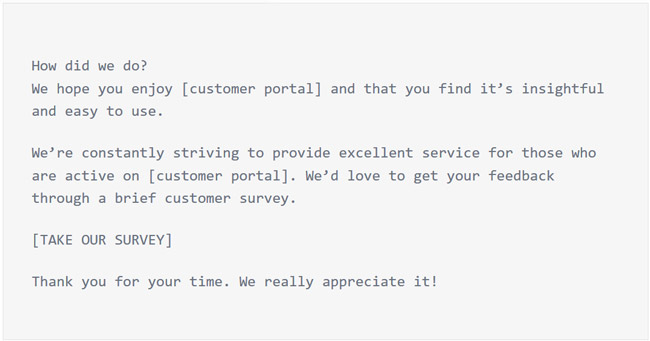
Here is a list of web pages that have product/service feedback email templates:
- Customer Feedback Email (Survicate)
- Feedback Email Templates (LiveAgent)
- How To Write A Customer Feedback Email With Sample Email Flow And Templates (Flowrite)
- 7 Feedback Email Template Examples (SurveySparrow)
- Product Feedback Survey Templates And Questionnaire Examples (Survicate)
- Building a Customer Feedback Email Template (+ 7 Examples) (Sendlane)
- 15 Survey Email Templates To Get More Responses (EmbedSocial)
Customize Your Own Templates
Need inspiration to help get you started? Download a free template and customize for your online store. Add your own voice, product images, discounts, offers and signature style.
Example 1
Example 2
Market Research Surveys Email Templates
“If you’re not meeting your visitors’ needs, it doesn’t matter how ‘optimized’ your site is.”
— Stoney deGeyter
Market research plays a vital role in gaining deep insights into the target audience and market trends.
Market research surveys email templates provide marketers with effective tools to gather data and make informed business decisions by providing:
- Enhanced understanding of customers: These surveys help you gather key demographic and psychographic data about your audience. This kind of information helps you create customer personas and tailor your marketing efforts to fit their needs and preferences.
- Product development insight: Market research templates can be a goldmine for learning what features your target market loves, what needs improvement, or what they wish your product had.
- Competition analysis: You can find out how you stack up against competitors in your customer’s eyes. Are there areas where your competition is outperforming you? This knowledge lets you strategize to get ahead.
Caution: Be cautious with the way you interpret your survey results; biases can distort your understanding and lead to wrong business decisions.
The Power of Well-Crafted Market Research Survey Emails
“The aim of marketing is to know and understand the customer so well the product or service fits him and sells itself.”
— Peter Drucker
Creating effective market research survey email templates is key to getting valuable audience insights about your market, competition, and customer preferences. Here’s what a market research email generally includes:
- Engaging subject line: The first step to getting respondents is to make them open your email. An interesting, relevant subject line is crucial here.
- Personalized greeting: Just like with feedback emails, using the customer’s name makes the interaction feel more personal and tailored.
- Explanation of purpose: Clearly state why you’re conducting the survey and how the respondent’s input will be beneficial. This gives them a reason to participate.
- Survey link or embedded survey: Make it as easy as possible for the recipient to take your survey. A prominent, easy-to-find link or an embedded survey within the email works best.
- Estimated time to complete: Be transparent about how long the survey will likely take. If it’s short, that’s a selling point. If it’s longer, you might need to offer an incentive to ensure completion.
Conclude with a thank you note that shows appreciation for their time and willingness to help.
The image below showcases a professionally designed email template for market research data collection.
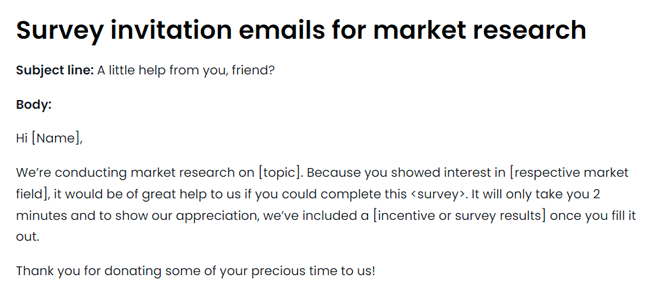
Here is a list of web pages that have market research surveys email templates:
- Free Market Research Survey Templates and Questions (SurveyMonkey)
- Free Market Research Surveys & Marketing Surveys (QuestionPro)
- Market Research Survey Templates (Typeform)
- Marketing Survey Templates (Jotform)
- Survey Email Templates And Best Practices For Engagement (Yet Another Mail Merge)
- 15 Survey Email Templates To Get More Responses (EmbedSocial)
- How To Do Market Research: A Guide And Template (HubSpot Blog)
Customize Your Own Templates
Need inspiration to help get you started? Download a free template and customize for your online store. Add your own voice, product images, discounts, offers and signature style.
Example 1
Example 2
Website/App Feedback Email Templates
Website or app feedback is an integral part of enhancing your digital experience, making your platform more user-friendly, and boosting engagement.
Website/app feedback email templates are instrumental for businesses in gathering crucial data about their digital platforms:
- Identifying usability issues: These emails can help collect information about difficulties users might be experiencing while navigating your site or app. Knowing where users struggle most allows you to prioritize those areas for improvement.
- Gathering user suggestions: Feedback can include valuable ideas and suggestions from users that can help improve the website or app. They might see a need for a feature or service that you hadn’t considered before.
- Understanding user satisfaction: By asking for feedback, you can gauge the overall satisfaction of users with your website or app. This can help you understand what is working well and what needs improvement.
Impactful website/app feedback email templates involve several key elements:
- Intriguing subject line: The initial step to eliciting responses is to entice users to open your email. A compelling, pertinent subject line is essential.
- Personalized salutation: As with other customer-centric emails, using the user’s name makes the conversation feel more individual and tailored.
- Purpose clarification: Explain clearly why you are requesting feedback and how their insights will contribute to improvements. This gives them a valid reason to engage.
- Link to the feedback form: Ensure the process of giving feedback is as frictionless as possible. Incorporate an easy-to-spot link or embed the feedback form within the email.
- Estimated completion time: Be honest about how long it will take to provide feedback. If the process is quick, use it as an appealing point. If it requires more time, consider offering a token of appreciation for their effort.
Here’s an example of a professionally designed website/app feedback email template.
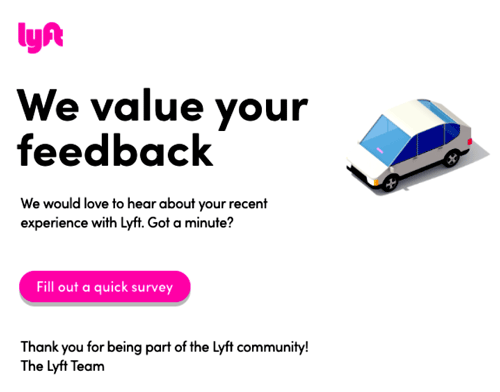
Here is a list of web pages that have website/app feedback email templates:
- 5 Effective Email Feedback Templates That Will Boost Engagement (Mopinion)
- 7 Feedback Email Template Examples (SurveySparrow)
- User Review (Unlayer)
- Building A Customer Feedback Email Template (+ 7 Examples) (Sendlane)
- How To Create Great Customer Feedback Email Templates (Help Scout)
- 11 Responsive Feedback Email Templates For Businesses (6Q)
- 12 Feedback Email Examples: How To Convince Saas Customers To Share Their Opinion + Free Template (Userlist)
Customize Your Own Templates
Need inspiration to help get you started? Download a free template and customize for your online store. Add your own voice, product images, discounts, offers and signature style.
Example 1
Example 2
Content Feedback Email Templates
Content feedback email templates serve as a valuable tool for marketers to gather insights on the quality, relevance, and effectiveness of their content.
These templates enable marketers to collect feedback from their audience regarding blog posts, articles, videos, social media content, and other forms of content they produce.
Content feedback email templates provide a structured approach for businesses to gather crucial insights about their content and:
- Evaluate engagement: Feedback emails allow readers to share their views about the content, helping you understand what resonated well and what didn’t.
- Collect suggestions: Readers often provide valuable ideas for content enhancements. This can give you fresh perspectives and enable you to innovate for future content.
- Measure satisfaction: Feedback enables you to measure reader satisfaction, giving you a direct measure of the content’s success and areas where you can improve.
Crafting Powerful Content Feedback Emails
Effective content feedback email templates typically include the following elements:
- Engaging subject line: This aims to catch the attention of the recipient and stimulate their curiosity to open the email. For example, “Your Insights Can Shape Our Next Blog Post” or “Help Us Improve: Your Opinion on Our Content Matters.”
- Personalized greeting: Personalization creates a sense of individual attention. For instance, instead of saying, “Dear Reader,” use “Dear ,” This simple touch can make your recipients feel more willing to respond.
- Clear explanation: The reason for asking for feedback needs to be evident.
For example, you can say, “Your thoughts and impressions about our recent content are essential for us to make our future content even better. Please take a few minutes to share your feedback with us.” - Direct link to feedback form: The easier it is for readers to leave feedback, the more likely they are to do so. Instead of guiding them through a complicated process, provide a direct link or an embedded form in your email.
- Estimated completion time: Telling your recipients how much time they need can increase the response rate. For example, if your survey is short, you can highlight this by saying, “This survey will only take 2 minutes of your time.”
End by thanking the reader for their time and input, e.g., “We appreciate your invaluable input. Your feedback helps us improve and shape our future content to suit your needs. Thank you for your time and contribution.”
The image below showcases a content feedback email template.
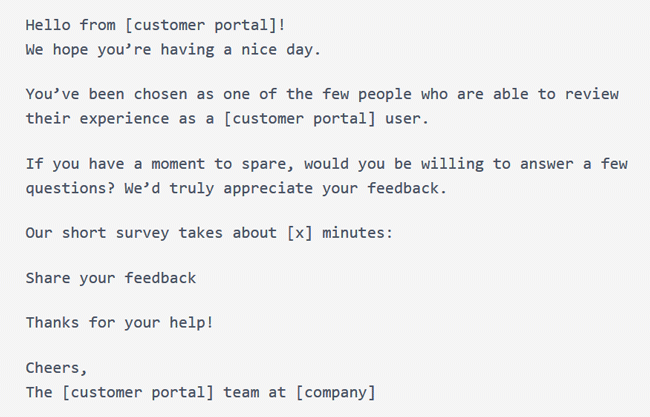
Here is a list of web pages that have content feedback email templates:
- Seminar Feedback Survey Template (Zoho Survey)
- Template Gallery (Paperform)
- 11 Excellent Tips To Ask Clients For Reviews Via Email (And Finally Get Them) (Trust)
- 6 Email Templates To Use When Asking For Reviews (Brafton)
- Asking For Feedback Email With 20 Samples And Templates (Flowrite)
Customize Your Own Templates
Need inspiration to help get you started? Download a free template and customize for your online store. Add your own voice, product images, discounts, offers and signature style.
Example 1
Example 2
Event Feedback Email Templates
Event feedback plays a significant role in making your gatherings more successful, memorable, and relevant to your audience’s needs.
Event feedback email templates provide a structured approach for businesses to gather crucial insights about their events:
- Evaluating success: Feedback emails allow attendees to share their views about the event, helping you understand what worked well and what didn’t.
- Collecting suggestions: Attendees often provide valuable ideas for enhancements. This can give you fresh perspectives and enable you to innovate for future events.
- Measuring satisfaction: Feedback enables you to measure attendee satisfaction, giving you a direct measure of the event’s success and areas where you can improve.
Importantly, treat each piece of feedback as a learning opportunity. While some feedback might not be flattering, it provides an opportunity to improve and create even more impactful events.
Crafting Powerful Event Feedback Emails
Effective event feedback email templates typically include the following elements:
- Engaging subject line: This aims to catch the attention of the recipient and stimulate their curiosity to open the email.
For example, “Your Insights Can Shape Our Next Event.” or “Help Us Improve: Your Opinion Matters.” are engaging and suggest the importance of the attendee’s feedback. - Personalized greeting: Personalization creates a sense of individual attention. For instance, instead of saying, “Dear attendee,” use “Dear ,”. This simple touch can make your recipients feel special and more willing to respond.
- Clear explanation: The reason for asking for feedback needs to be evident.
For example, you can say, “Your thoughts and impressions about our recent event are essential for us to make our future events even better. Please take a few minutes to share your feedback with us.” - Direct link to feedback form: The easier it is for attendees to leave feedback, the more likely they are to do so.
Instead of guiding them through a complicated process, provide a direct link or an embedded form in your email, like: “Please click here to complete the survey” or “Find the feedback form embedded below.” - Estimated completion time: Telling your recipients how much time they need can increase the response rate.
For example, if your survey is short, you can highlight this by saying, “This survey will only take 3 minutes of your time.” If it’s a longer survey, offer some incentive, like: “Spare 10 minutes to complete this survey, and get a chance to win a $50 gift card.”
End by thanking the attendee for their time and input, e.g., “We appreciate your invaluable input. Your feedback helps us improve and shape our future events to suit your needs. Thank you for your time and contribution.”
Below is an example of an expertly crafted event feedback email template designed to effectively gather attendee insights and opinions.
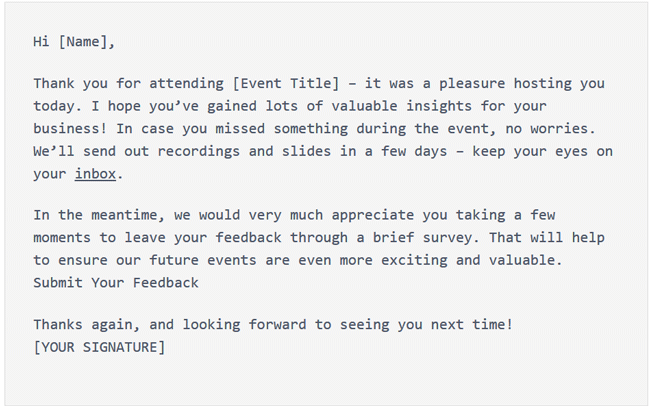
Here is a list of web pages that have event feedback email templates:
- Event Feedback Survey Template: Rate The Event (SurveyMonkey)
- Professional Event Feedback Survey Template (SurveyMonkey)
- Event Follow-Up Email Templates (LiveAgent)
- “Thank You For Attending!” Email Template Ideas For Attendees, Speakers, Hosts, Sponsors, And More (Bizzabo)
- How To Write An Event Follow-Up Email, From Subject Line To CTA (+ Template) (Eventbrite)
Customize Your Own Templates
Need inspiration to help get you started? Download a free template and customize for your online store. Add your own voice, product images, discounts, offers and signature style.
Example 1
Example 2
Employee Satisfaction Surveys Email Templates
“We all need people who will give us feedback. That’s how we improve.”
— Bill Gates
Employee satisfaction surveys are a valuable tool for gathering feedback and insights from employees within an organization. They touch on:
- Uncovering pain points: These templates provide a structured platform for employees to express their views about their job and the company, giving you insights into areas that might be causing dissatisfaction.
- Collecting suggestions: Often, employees will offer solutions or suggestions for improvement in these surveys. Implementing these suggestions can lead to increased satisfaction, productivity, and employee retention.
- Measuring job satisfaction: Regularly checking in with employees about their satisfaction levels helps you track the effectiveness of your current workplace practices and make necessary adjustments.
Building Effective Employee Satisfaction Surveys Emails
An effective employee satisfaction survey email must be clear, respectful of the employee’s time, and stress the importance of their feedback in improving the workplace. It typically includes:
- Engaging subject line: Prompt your employees to open the email by crafting an appealing subject line that emphasizes the importance of their feedback.
An example might be “Help Us Create a Better Workplace for You” or “Your Voice Matters: Share Your Experience.” - Personalized greeting: Addressing your employees by their name adds a personal touch and can enhance response rates.
Rather than using generic salutations like “Dear employee,” use “Dear .” This makes the employee feel recognized and valued. - Purpose explanation: Clearly state why you’re conducting the survey and how the feedback will help enhance the workplace environment.
For example, “We’re committed to making our company the best place to work. To do this, we need your honest feedback about your experience at our company.” - Survey link: Simplify the process of taking the survey by including a straightforward link or embedding the survey within the email.
This can be something like, “Click here to start the survey” or “Please find the survey embedded in this email.” - Time estimation: Indicate how long the survey will take. If it’s short, stress this point, such as “This survey will only take about 5 minutes of your time.”
If it’s longer, communicate the significance of their detailed feedback, e.g., “This 15-minute survey is crucial in helping us understand and enhance our workplace environment.”
Wrap up with a note of gratitude thanking them for their time and valuable insights.
The image below showcases an email template for conducting employee satisfaction surveys.
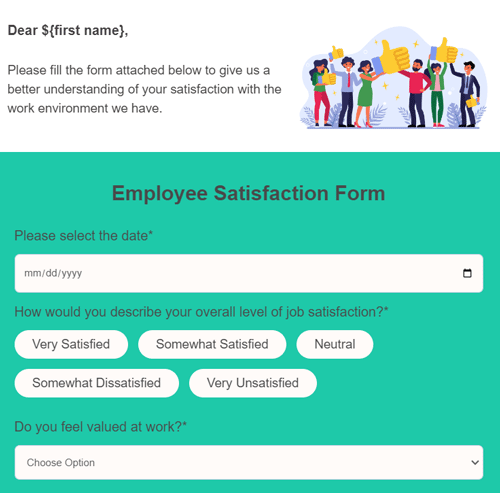
Here is a list of web pages that have employee satisfaction surveys email templates:
- 10 Employee Satisfaction Survey Templates And Questions To Ask (ContactMonkey)
- Email Templates For Engagement Surveys (15Five)
- Free Employee Satisfaction Survey Email Template (Mailmodo)
- 15 Sample Email Templates To Address (And Improve) Employee Performance (Officevibe)
- Employee Satisfaction Survey Templates (Typeform)
- Employee Feedback Forms And Templates (SurveyMonkey)
Customize Your Own Templates
Need inspiration to help get you started? Download a free template and customize for your online store. Add your own voice, product images, discounts, offers and signature style.
Example 1
Example 2
Brand Perception and Awareness Email Templates
Brand perception and awareness are vital pillars for a company’s success. It influences how customers perceive your brand, its reach, and its reputation.
Brand perception and awareness email templates offer a structured way for businesses to gather key insights about their brand:
- Unearthing brand image: Such emails provide an opportunity for customers to express their views about your brand. This feedback is crucial to understanding how your brand is perceived in the marketplace.
- Collecting customer views: Customers often provide critical insight into how your brand’s messaging, values, and customer experience align with their expectations. Their suggestions can lead to brand-enhancing improvements.
- Measuring brand awareness: Regularly surveying your customers and target market about your brand helps gauge the success of your branding efforts and informs strategies for improving brand awareness.
Crafting Impactful Brand Perception and Awareness Emails
Constructing a powerful brand perception and awareness survey email includes the following aspects:
- Engaging subject line: Catch your customers’ attention with a compelling subject line that underlines the importance of their opinion.
Examples include: “Help Us Understand You Better: Share Your Thoughts About ” or “We Value Your Insight on .” - Personalized greeting: A personal touch can enhance engagement. Address your customers by their name to create a more personal connection.
- Purpose explanation: Clearly state why you’re conducting the survey and how their feedback will help enhance the brand.
For instance: “We’d love to know more about your perception of . Your insights will help us tailor our offerings and communications to better meet your needs.” - Survey link: Ensure it’s easy for customers to participate by including a straightforward link or embedding the survey within the email.
For example: “Click here to share your thoughts about ” or “You can find the survey embedded in this email below.”
Quick Fact: An engaging subject line can increase email open rates by 50%. Craft something that speaks directly to your customer’s interests and needs.”
Below is an image of a brand perception surveyl.
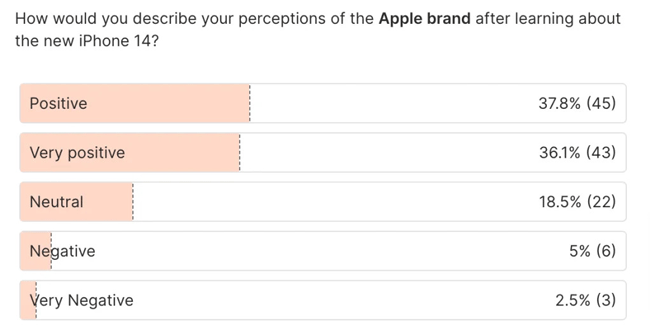
Here is a list of web pages that offer email templates that can be used to promote brand perception and awareness:
- Brand Perception Survey Template (Attest)
- Brand Awareness Survey Template (Sogolytics)
- Brand Awareness Survey (SurveyMonkey)
- 60+ Best Brand Awareness Survey Questions And Examples (Qualaroo)
- Brand Perception Survey Template (Typeform)
Customize Your Own Templates
Need inspiration to help get you started? Download a free template and customize for your online store. Add your own voice, product images, discounts, offers and signature style.
Example 1
Example 2
New Feature Prioritization Survey Templates
“You can’t just ask customers what they want and then try to give that to them. By the time you get it built, they’ll want something new.”
— Steve Jobs
New feature prioritization feedback plays a significant role in making your product more successful, user-friendly, and relevant to your customers’ needs.
New feature prioritization survey templates provide a structured approach for businesses to gather crucial insights about their products:
- Evaluating demand: Feedback surveys allow users to share their views about the proposed features, helping you understand what is most needed and what isn’t.
- Collecting suggestions: Users often provide valuable ideas for feature enhancements. This can give you fresh perspectives and enable you to innovate for future product updates.
- Measuring satisfaction: Feedback enables you to measure user satisfaction with current features, giving you a direct measure of the product’s success and areas where you can improve.
Crafting Powerful New Feature Prioritization Surveys
Effective new feature prioritization survey templates typically include the following elements:
- Engaging subject line: This aims to catch the attention of the recipient and stimulate their curiosity to open the email. For example, “Help Shape the Future of Our Product” or “Your Input Needed: Prioritize New Features for .”
- Personalized greeting: Personalization creates a sense of individual attention. Instead of saying, “Dear User,” use “Dear ,”. This simple touch can make your recipients feel more willing to respond.
- Clear explanation: The reason for asking for feedback needs to be evident.
For example, you can say, “Your thoughts and preferences about our proposed new features are essential for us to make our product even better. Please take a few minutes to share your feedback with us.” - Direct link to feedback form: The easier it is for users to leave feedback, the more likely they are to do so. Instead of guiding them through a complicated process, provide a direct link or an embedded form in your email.
- Estimated completion time: Telling your recipients how much time they need can increase the response rate. For example, if your survey is short, you can highlight this by saying, “This survey will only take 5 minutes of your time.”
End by thanking the user for their time and input, e.g., “We appreciate your invaluable input. Your feedback helps us improve and shape our product’s future features to suit your needs. Thank you for your time and contribution.”
The image showcases a professionally designed email for gathering insights on new features.

Here is a list of web pages that offer email templates that can be used for new feature prioritization surveys:
- Product Feature Prioritization Survey Template (Survicate)
- Feature Prioritization Survey (Qualtrics)
- Feature Prioritization Survey (Hotjar)
- Product Update/Feature Interest Survey (Voxco)
- How To Prioritize What Product Features To Build Next (YesInsights)
Customize Your Own Templates
Need inspiration to help get you started? Download a free template and customize for your online store. Add your own voice, product images, discounts, offers and signature style.
Example 1
Example 2
Demographic and Customer Profile Surveys Email Templates
Customer profiling plays a crucial role in understanding the persona of your customer base, allowing businesses to cater to their specific needs and wants.
Demographic and customer profile survey templates offer businesses an efficient means to gather this crucial information:
- Uncovering customer persona: These emails help collect essential demographic information such as age, gender, location, income level, and occupation.
This data assists in understanding who your customers are and what they might need or want from your business. - Recognizing patterns: By analyzing demographic and customer profile surveys, you can identify trends or patterns in customer behavior, enabling more accurate marketing and product development strategies.
- Segmentation: The data collected through these surveys is key for effective segmentation, ensuring you send the most relevant messaging to each audience segment.
Designing Effective Demographic and Customer Profile Surveys Emails
Impactful demographic and customer profile email templates involve several key steps:
- Engaging subject line: Craft an enticing subject line that encourages recipients to participate in the survey. Examples include: “Help Us Tailor Your Experience with ” or “We Value Your Insights: Help Us Get to Know You Better.”
- Personalized greeting: Adding a personal touch can enhance engagement and response rates. Use your customer’s name to make the interaction more personal.
- Purpose explanation: Clearly explain why you’re conducting the survey and how their feedback will help improve their experience with your brand.
For instance: “To better tailor our offerings and provide a more personalized experience, we’re interested in learning more about you. Your responses will help us improve your experience with .” - Survey link: Simplify the process of taking the survey by including a straightforward link or embedding the survey within the email.
For example: “Click here to start the survey” or “You’ll find the survey embedded below in this email.”
Here is an image of a customer profile survey.
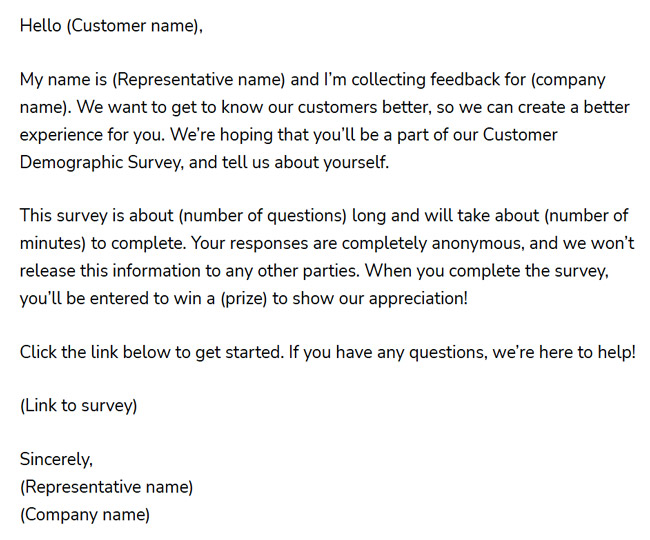
Here is a list of web pages that offer email templates that can be used for demographic and customer profile surveys:
- Demographic Survey (Jotform)
- Consumer Demographics And Interests Survey Questions + Sample Questionnaire Template (QuestionPro)
- Demographic Survey Questions: Why & How To Ask (SurveyMonkey)
- How To Ask For Feedback From Customers: 6 Templates (Boast)
- Customer Profiling Survey Template (Formplus)
- List Of Psychographic & Demographic Survey Templates (QuestionPro)
- Demographic Survey Questions & Examples (Qualaroo)
- Target Market Survey Template (Typeform)
- Target Market Demographics Survey (Zoho Survey)
- 8 Demographic Survey Questions To Help You Create A Better Buyer Persona (Getsitecontrol)
Customize Your Own Templates
Need inspiration to help get you started? Download a free template and customize for your online store. Add your own voice, product images, discounts, offers and signature style.
Example 1
Example 2
Unlocking Insights: Harnessing the Power of Customer Feedback Email Templates
“The customer’s perception is your reality.”
— Kate Zabriskie
As we have unpacked in this lively discussion, “Asking the Right Way” is not just about tossing questions into the digital universe and hoping for useful responses. Survey invitations are an art, a science, and require a bit of magic sprinkled in for good measure.
The range of templates we’ve discussed—from customer satisfaction and product/service feedback to market research—each plays a unique role in your digital marketing toolbox.
Harnessing these email templates for feedback gathering is like inviting your customers to a friendly conversation. You gain priceless insights that can drive business growth and innovation, while your customers get the chance to voice their thoughts and feel genuinely heard.
Every piece of feedback, every response, is a gift that helps you understand your market better, improve your offerings, and yes, even spot the new trends before they become mainstream.
Looking to discover more cutting-edge marketing strategies that differentiate winners from the crowd? Join our newsletter today for exclusive tips and start leading the curve.



